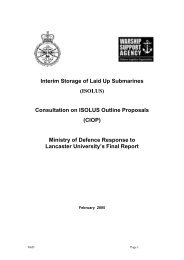Part III - Historical Survey of the Porton Down Service Volunteer ...
Part III - Historical Survey of the Porton Down Service Volunteer ...
Part III - Historical Survey of the Porton Down Service Volunteer ...
You also want an ePaper? Increase the reach of your titles
YUMPU automatically turns print PDFs into web optimized ePapers that Google loves.
8.4.5. Bronchial constriction.<br />
The study conducted in 1952 [51] to link ChE inhibition with vapour dose also looked at <strong>the</strong><br />
effect <strong>of</strong> those doses on respiratory functions. Breathing rates, maximum breathing capacity<br />
and air velocity index (among o<strong>the</strong>rs) were measured as indicators <strong>of</strong> bronchial constriction.<br />
But <strong>the</strong> report concluded that none <strong>of</strong> <strong>the</strong>se functions showed any "marked and consistent<br />
variation" after GB vapour exposures <strong>of</strong> up to <strong>the</strong> equivalent <strong>of</strong> about 20 mg.min/m 3 were<br />
administered.<br />
These results were considered to be "somewhat vague" and so fur<strong>the</strong>r work was conducted<br />
in 1953 to explore bronchial constriction [50]. Features <strong>of</strong> GB poisoning included impaired<br />
functioning <strong>of</strong> <strong>the</strong> muscles controlling breathing, a narrowing <strong>of</strong> <strong>the</strong> airways and an increase<br />
in <strong>the</strong> secretion <strong>of</strong> mucus into <strong>the</strong> airways. The last two effects obstruct <strong>the</strong> flow <strong>of</strong> air to <strong>the</strong><br />
lungs (equivalent to increasing airway resistance) and can impede artificial respiration [50]. A<br />
single breath study was carried out in which 18 men brea<strong>the</strong>d in doses between 0.78 and<br />
2.87 µg/kg to establish if airway resistance was increased by low doses <strong>of</strong> GB vapour.<br />
The main conclusions were as follows:<br />
• 10 mg.min/m 3 produces a measurable increase in airway resistance;<br />
• with this exposure level, resistance was 3 to 4 times higher than normal in some<br />
men. But this increase did not cause any significant "respiratory embarrassment"<br />
(or breathing difficulty). This was because in healthy humans <strong>the</strong> respiratory<br />
reserve is large and substantial airflow resistance can be tolerated;<br />
• however, it might be inferred that with larger doses "o<strong>the</strong>r factors reducing<br />
available respiratory effort" would make airway resistance or bronchial<br />
constriction less tolerable.<br />
8.4.6. Psychological effects <strong>of</strong> GB vapour<br />
The 1945 trial assessing <strong>the</strong> ability <strong>of</strong> infantrymen and <strong>Porton</strong> civilian staff to perform tasks<br />
after being exposed to GA suggested some impairment in function [18], but <strong>the</strong> results were<br />
uncertain because not much was known about <strong>the</strong> intelligence <strong>of</strong> <strong>the</strong> participants.<br />
Two studies were carried out in 1952 and 1953 each using tests to measure intellectual and<br />
visual performance, rate <strong>of</strong> learning and weariness/boredom. These tests were conducted by<br />
<strong>the</strong> participants before and after exposure to GB vapour. The intelligence <strong>of</strong> <strong>the</strong> men taking<br />
part was assessed before exposure. The first study [53] exposed 20 men to GB at<br />
10 mg.min/m 3 (t = 2 mins), while 8 o<strong>the</strong>r men who performed <strong>the</strong> same tests underwent no<br />
exposure and served as a control group. The main results were as follows:<br />
• normal physiological symptoms (miosis, headache, tightness <strong>of</strong> chest) developed<br />
as expected. The men exposed to vapour felt lethargic and "couldn't be<br />
bo<strong>the</strong>red", even though <strong>the</strong>y were not feeling bored or resentful. No deterioration<br />
was observed in intelligence. Efficiency in visual tasks was impaired and<br />
learning was slower;<br />
• general anxiety dreams were reported by several men;<br />
• <strong>the</strong> average ChE inhibition induced by <strong>the</strong> dose <strong>of</strong> GB vapour was 31.4% but it<br />
was not possible to link personal ChE inhibition with scores obtained in <strong>the</strong><br />
performance tests.<br />
The second study [54] followed similar lines. The GB exposure was higher, 14.7 mg.min/m 3<br />
(t = 2 mins); 12 men experienced this exposure. A control group <strong>of</strong> 12 men was exposed to a<br />
tear gas (CN). Intelligence ratings <strong>of</strong> <strong>the</strong> men involved were obtained from <strong>the</strong> <strong>Service</strong>s. The<br />
report concluded:<br />
68









